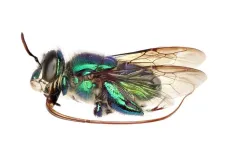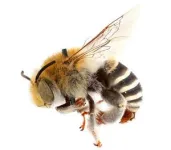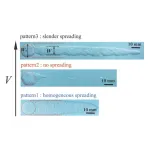(Press-News.org) PULLMAN, Wash. –The origin of bees is tens of millions of years older than most previous estimates, a new study shows.
A team led by Washington State University researchers traced the bee genealogy back more than 120 million years to an ancient supercontinent, Gondwana, which included today’s continents of Africa and South America.
In a study that proposes a new evolutionary history of bees, the researchers found evidence that bees originated earlier, diversified faster and spread wider than many scientists previously suspected. They published their findings in the journal Current Biology.
“There’s been a longstanding puzzle about the spatial origin of bees,” said Silas Bossert, assistant professor with WSU’s Department of Entomology, who co-led the project with Eduardo Almeida, associate professor at the University of São Paulo, Brazil.
Working with collaborators on every continent who assisted with sampling and computational analysis, Bossert and Almeida’s team sequenced and compared genes from more than 200 bee species. They compared them with traits from 185 different bee fossils, as well as extinct species, developing an evolutionary history and genealogical models for historical bee distribution. In what may be the broadest genomic study of bees to date, they analyzed hundreds to thousands of genes at a time to make sure that the relationships they inferred were correct.
“This is the first time we have broad genome-scale data for all seven bee families,” said co-author Elizabeth Murray, a WSU assistant professor of entomology.
Previous research established that the first bees likely evolved from wasps, transitioning from predators to collectors of nectar and pollen. This study shows they arose in arid regions of western Gondwana during the early Cretaceous period.
“For the first time, we have statistical evidence that bees originated on Gondwana,” Bossert said. “We now know that bees are originally southern hemisphere insects.”
The researchers found evidence that as the new continents formed, bees moved north, diversifying and spreading in a parallel partnership with angiosperms, the flowering plants. Later, they colonized India and Australia. All major families of bees appeared to split off prior to the dawn of the Tertiary period, 65 million years ago—the era when dinosaurs became extinct.
The tropical regions of the western hemisphere have an exceptionally rich flora, and that diversity may be due to their longtime association with bees, authors noted. One quarter of all flowering plants belong to the large and diverse rose family, which make up a significant share of the tropical and temperate host plants for bees.
Bossert’s team plans to continue their efforts, sequencing and studying the genetics and history of more species of bees. Their findings are a useful first step in revealing how bees and flowering plants evolved together. Understanding how bees spread and filled their modern ecological niches could also help keep pollinator populations healthy.
“People are paying more attention to the conservation of bees and are trying to keep these species alive where they are,” Murray said. “This work opens the way for more studies on the historical and ecological stage.”
Additional contributors included Felipe Freitas, Washington State University; Bryan Danforth, Cornell University; Charles Davis, Harvard University; Bonnie Blaimer, Tamara Spasojevic, and Seán Brady, Smithsonian Institution; Patrícia Ströher and Marcio Pie, Federal University of Paraná, Brazil; Michael Orr, State Museum of Natural History, Stuttgart; Laurence Packer, York University; Michael Kuhlmann, University of Kiel; and Michael G. Branstetter, U.S. Department of Agriculture.
View the article in Current Biology.
END
Bees likely evolved from ancient supercontinent, earlier than suspected
2023-07-31
ELSE PRESS RELEASES FROM THIS DATE:
Routinely drinking alcohol may raise blood pressure even in adults without hypertension
2023-07-31
Research Highlights:
An analysis of data from seven studies involving more than 19,000 adults in the United States, Korea and Japan found a clear association between increases in systolic (top-number) blood pressure and the number of alcoholic beverages consumed daily.
Even people who drank one alcoholic beverage per day showed a link to higher blood pressure when compared to non-drinkers, reinforcing the American Heart Association’s advice to limit alcohol intake and to not start drinking alcohol if you do not already.
Embargoed until ...
This disease can be caused by a food allergy and prevent children from eating. A new study may show how to treat it
2023-07-31
A new study from Tulane University has identified a new treatment for a chronic immune system disease that can prevent children from eating.
Eosinophilic esophagitis (EoE) is triggered by food allergies or airborne allergens which causes a type of white blood cell, eosinophils, to build up in the lining of the esophagus. This causes the esophagus to shorten and the esophageal wall to thicken, making swallowing difficult and causing food to get stuck in the throat.
The disease occurs in an estimated 1 in 2,000 adults but more frequently affects children (1 in 1,500) where symptoms can be harder to diagnose and pose greater risks as difficulty feeding can lead to malnutrition, weight loss and ...
Oxycodone prescriptions after delivery not linked to longer-term opioid use compared to codeine prescriptions
2023-07-31
Postpartum prescriptions for oxycodone were not associated with increased risk of longer-term opioid use compared to codeine prescriptions, according to new research published in CMAJ (Canadian Medical Association Journal) https://www.cmaj.ca/lookup/doi/10.1503/cmaj.221351.
Over the last 10 years, there has been a shift to fewer codeine prescriptions and an increase in prescriptions for stronger opioids, such as hydrocodone, hydromorphone and oxycodone for patients postpartum.
“This occurred in part ...
Novel vaccine may hold key to prevent or reduce the impact of Alzheimer’s disease
2023-07-30
Research Highlights:
A novel vaccine that targets a protein involved in Alzheimer’s disease helped eliminate toxic cells in mice with the condition.
After vaccination, the mice had fewer amyloid plaques and less inflammation in brain tissue and showed improvement in behavior and awareness.
Embargoed until 12 p.m. CT/1 p.m. ET, Sunday, July 30, 2023
BOSTON, July 30, 2023 — A novel vaccine that targets inflamed brain cells associated with Alzheimer’s disease may hold the key to potentially preventing or modifying the course of the disease, according to preliminary research presented at the American Heart Association’s Basic Cardiovascular Sciences Scientific ...
To spread or slide? Scientists uncover how foams are spread on surfaces
2023-07-29
Tokyo, Japan – Researchers from Tokyo Metropolitan University have uncovered the physics behind how foams are spread on surfaces. Balls of foam placed on a flat substrate were scraped across with a plate and observed. They identified different patterns which strongly depend on the scraping speed, governed by competing physical phenomena. Their findings apply to all kinds of soft materials that need to be spread evenly on surfaces, from mayonnaise on bread to insulation on walls.
Whether ...
How to save the NHS – an expert prescription
2023-07-29
Whether it’s setting up a Bank of England-type body to run it or fining patients for missing appointments, healthcare leaders, policymakers and practitioners past and present have a wealth of ideas about how they would change the NHS for the better.
Professor Dinesh Bhugra, a psychiatrist and former president of the British Medical Association and the Royal College of Psychologists, asked 14 peers, physicians and patients’ representatives for their prescription for the NHS.
The interviews are reproduced in Professor Bhugra’s new book, Conversations about the NHS. Thought-provoking and in some cases, controversial, ideas include:
Setting ...
Unlocking a mystery of fetal development
2023-07-28
As with many toxins, exposure to the toxic metal cadmium during pregnancy can adversely impact fetal development. Now, researchers at the Rutgers School of Public Health think they’re beginning to understand how the metal inflicts its damage: by disrupting placental hormones that regulate pregnancy physiology.
Unlike other toxins, relatively little cadmium crosses the placenta to directly impact the fetus. Instead, the placenta concentrates cadmium in its tissue at rates of up to six times that found in umbilical cord serum.
“We already know a lot about cadmium and its detrimental impacts on fetal health, such ...
How breast milk boosts the brain
2023-07-28
A new study by scientists at the Jean Mayer USDA Human Nutrition Research Center on Aging (HNRCA) at Tufts University suggests that a micronutrient in human breast milk provides significant benefit to the developing brains of newborns, a finding that further illuminates the link between nutrition and brain health and could help improve infant formulas used in circumstances when breastfeeding isn’t possible.
The study, published July 11 in the Proceedings of the National Academy of Sciences (PNAS), also paves the way to study what role this micronutrient might play in the brain as ...
New study findings underscore the importance of timely newborn screenings in early care for cystic fibrosis
2023-07-28
Aurora, Colo. (July 28, 2023) – The Journal of Pediatrics has published a manuscript by Stacey Martiniano, MD, pulmonary specialist at Children’s Hospital Colorado and associate professor of pediatrics at the University of Colorado. Dr. Martiniano was primary author on the study titled, Late Diagnosis in the Era of Universal Newborn Screening Negatively Effects Short- and Long-Term Growth and Health Outcomes in Infants with Cystic Fibrosis. The manuscript’s senior author was Susanna McColley, MD, professor of pediatrics in pulmonary and sleep medicine at Northwestern University Feinberg ...
Royal Society of Chemistry honors Hong with fellow selection
2023-07-28
The Royal Society of Chemistry has named Yi Hong, a distinguished university professor of bioengineering at The University of Texas at Arlington, as a fellow.
Hong said he was honored by the selection.
“Chemistry is amazing because it helps to create many new biomedical materials for human health and life saving,” Hong said. “This recognition encourages me not only to invent more creative biomaterials through chemical design for disease treatment, but also to be a role model to our next generation of scientists and engineers ...





